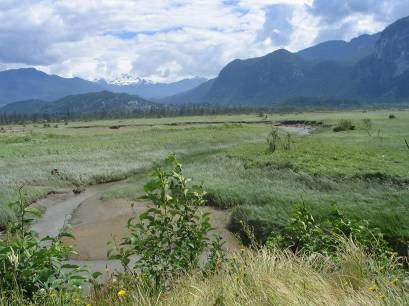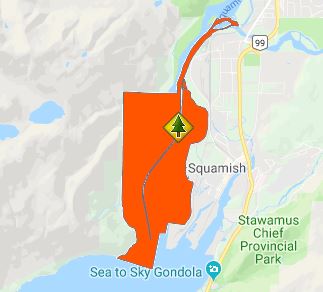Skwelwil'em Squamish Estuary Wildlife Management Area
Date Designated: February 28, 2007
Purpose: Maintenance and restoration of significant habitat for fish and wildlife species.
Size: 673 hectares
Region: South Coast
Nature and culture
Fish and Wildlife: Typical of an estuarine environment, the Squamish Estuary is a highly productive and valuable ecosystem. It provides wintering, migration, feeding and breeding habitats for waterfowl and shore birds, as well as for raptors, passerines and other species. It is a feeding, spawning and rearing ground for a variety of fish species, including provincially significant species such as Eulachon, Steelhead and salmon. The estuary also provides good habitat for a number of mammal species including Black-tailed Deer, Black Bear, Cougar, Coyote, moles, voles, and rabbits. Endangered species found here include Peregrine Falcon, Marbled Murrelet, and Keen’s Long-eared Myotis.
Physiography, Climate and Vegetation: This WMA is part of a fjord head estuary draining 3,650 square kilometres of coastal rainforest. Sedimentary environments of the delta front and intertidal zone include river mouth bars, tidal flats, and tidal marshes with sediments ranging from fines, silts and clays to well-washed, coarse-to-fine grained sands. Upland soils are predominantly podzolic. A variety of previous human uses and industrial activities have had significant impacts on the WMA and surrounding areas, and restoration work is in progress. The aquatic environment flourishes with a high concentration of phytoplankton, primarily large diatoms and dinoflagellates. Benthic or bottom dwelling algae are in high production at tidal flat sediments of mudflats, seagrass beds and saltmarshes. Highly productive salt marshes are the largest component of the estuarine environment, and are dominated by sedges, grasses, and rushes. The terrestrial environment includes shrub meadows and forests that are within the Coastal Western Hemlock biogeoclimatic zone.
Cultural Heritage: Traditional First Nations activities still take place within the WMA.
Planning and management
Information on management direction and possible restrictions on visitor activities are available from the Conservation Lands regional contacts.
Management Partners:
Image
The Skwelwil'em Squamish Estuary WMA is located 50 km north of Vancouver, at the head of Howe Sound in Squamish, B.C.



